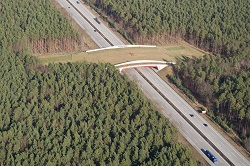Forest fragmentation a danger to vulnerable species
Publishing in the journal ‘Biological Conservation’, the research team have warned that breaking up the rainforest into ‘forest islands’ is resulting in more species having to live closer to the forest edge and that many are failing to adapt to such a changed environment. Studying over 100 species of reptiles and amphibians living in nine fragmented forest landscapes in Central and South America, they found that 90 % of all species were affected by the ‘forest edge effect’. Whilst a small number of species actually increased in abundance (due to having already adapted to living at the forest edge), the majority of species declined and the negative impact on them also extended far into the forest interior. Sampling in areas where the forests had been divided up to make way for farming or roads, the TERRAGEN research team, led by Newcastle University, UK, showed the average edge effect extended more than 250 metres into the forest. Consequently, this means that a forest island with a diameter of less than 500 metres would contain no viable ‘core’ area for many forest species. Now the researchers are calling for a new approach to forest conservation and management. ‘The rapid decline in the world’s rainforests is having a devastating effect on species numbers and diversity but until now there has been little information about the additional impact of forest fragmentation,’ commented Dr. Marion Pfeifer, one of the lead authors of the study. ‘In our study, we found the majority of amphibian and reptile species were negatively impacted the closer we got to the forest edge and in some cases, species disappeared altogether. The findings have strong implications for conservation in fragmented tropical landscapes and suggest large forest patches will need to be conserved to protect forest-dependent species and avoid loss of biodiversity.’ In the Brazilian Atlantic forest, more than 80 % of the fragments are less than 50 hectares and half of the remaining forest is closer than 100 metres from an edge, much smaller than the minimum needed to preserve species diversity. ‘These ‘edge zones’ differ structurally and functionally from the original forest,’ explained Dr. Pfeifer. ‘Edges are typically characterised by more open canopies, leading to reduced moisture, increased light, wind and maximum daily temperatures. This compares to the core where the dense canopies can filter up to 95 % of the solar radiation and the environment is more consistent.’ She pointed out that some species, particularly reptiles and amphibians, are more sensitive than others to changes in the microclimate, thus negatively impacted their chances of survival in the edge zone. Amphibians are the world’s most threatened group on the IUCN Red List of threatened species, the world’s most comprehensive source on the global conservation status of animal, fungi and plant species. The TERRAGEN research team assessed the abundance of 104 amphibian species and reptiles in 9 fragmented regions in the Neotropics and found that only 2 amphibians and 8 reptiles were not sensitive to the edge effect. Now the team is looking at the impact of forest fragmentation on other species, from insects and birds to mammals, and how this could be used to inform future conservation efforts and management strategies in fragmented forest landscapes. For this, the team will actively use an extensive dataset compiled within the Global Biofrag project, which is also led by Dr. Pfeifer. ‘Road expansion is a key priority for communities in this part of the world, so this research will be vital in helping to inform future management plans,’ she says. ‘Amphibians and reptiles are useful indicator species to assess the overall health of the forest ecosystem and the next step will be to work with local communities to see how we can best protect biodiversity under conflicting land demands.’ For more information please see: CORDIS project page
Countries
United Kingdom



